

SAINT LUCIA
Birdwatching
NICK TROUBETZKOY’S ANSE CHASTANET
Nick Troubetzkoy’s JADE MOUNTAIN


Anse Chastanet
What were Caribbean hotels like before trade winds were replaced by blasts of air conditioning, when morning exercise was a walk on the beach and when you sat watching the sunset instead of cable TV? You can still find that Classic Caribbean at Anse Chastanet on St. Lucia’s quiet southwestern coast where two magical peaks, the Pitons, leap from the sea and the mountains are covered with luminous greenery.
Architect owner Nick Troubetzkoy believes passionately in nature. So he created a hotel that makes the foliage and the flowers, the perfumes and the peaks, the sea and the bird songs an integral part of your vacation experience. The estate encompasses 600 lush tropical acres bordering two soft sand beaches. Not only do you get a World Heritage Site anchored by the twin peaks on land, the resort’s two crystal-clear bays are part of a designated marine reserve protecting miles of colorful coral reefs teeming with tropical fish.
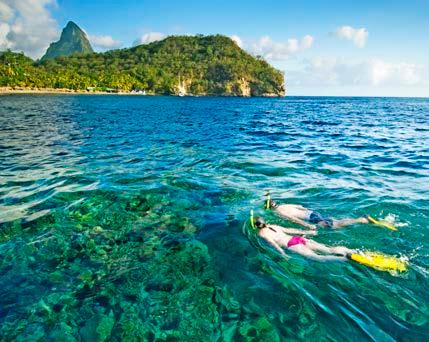
With such a unique setting as his canvas, Nick Troubetzkoy was inspired to design a one -of-a-kind resort. He was committed to an environmentally conscious development before “green” became fashionable.
A dozen rooms are tucked in behind the coconut palms that line the beach and the remainder tiptoe up a flower decked hillside. To make the most of the panoramic views and the refreshing tradewinds octagonal whitewashed cottages come with wraparound flower draped balconies and louvered windows.
Extra-large deluxe and premium suites underscore the visionary, innovative, sometimes whimsical side of Nick Troubetzkoy: in one suite, the balcony is built around a full-grown red gommier tree; in another a flamboyant tree drapes its red blossoms around the balcony. Some have their 4th wall open entirely to the vistas, yet are completely private.
Anse Chastanet’s ever growing art
collection provides a visual feast of its own. There are impressive wooden sculptures and plaques, earthy burlap compositions, painted “sky ceilings” and vibrant acrylic paintings invoking memories of Matisse and Picasso.
And while the sensuous seclusion of the rooms provides some guests with the perfect excuse for lolling away the day on the balcony, others head out to partake in the many activities on offer: yoga, snorkeling, scuba diving, tennis, sunset sailing, sea kayaking or jungle biking, hiking and birdwatching among the ruins of an 18th century colonial plantation.
The less actively inclined simply do nothing, lie on the beach or get pampered in the resort’s spa, Kai Belté. There is a casual beachside bar and restaurant; on the hillside, a panoramic hillside lounge and two treehouses provide the romantic setting for candlelit dinners, with musical backdrops by local entertainers. Tranquility, Romance and Adventure at Anse Chastanet.


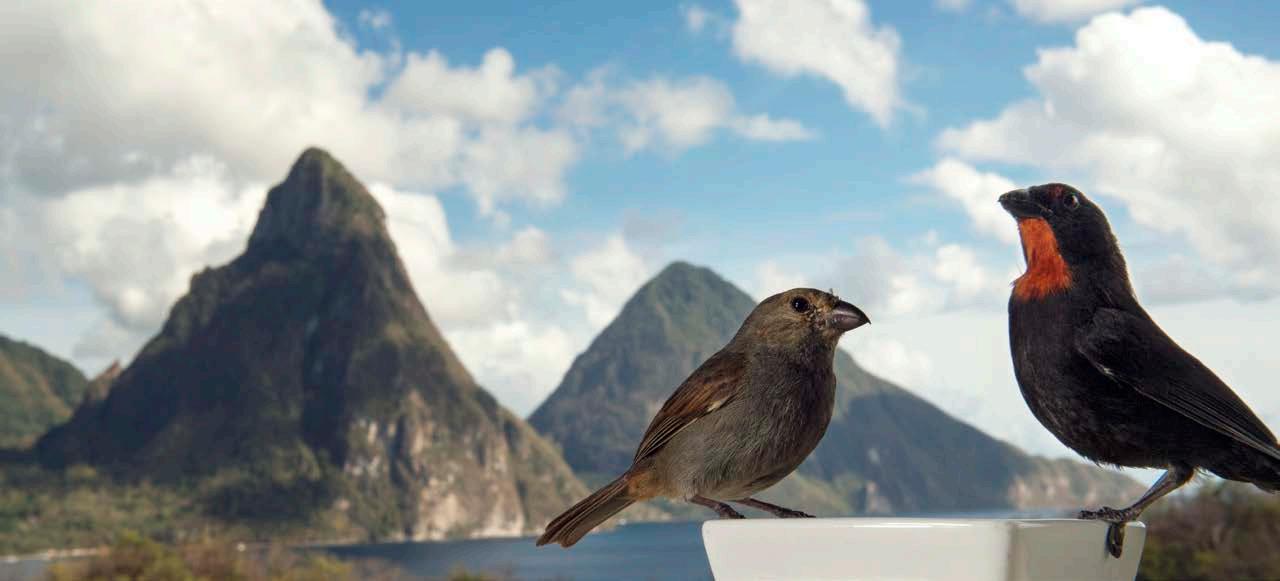
Birdwatching in Saint Lucia
Home to the magical Piton Mountains, lush landscapes, unspoilt rainforests and palm-fringed beaches, Saint Lucia is the beautiful Caribbean island that has it all and more.
From a birding point of view, Saint Lucia is very accessible being just 27 miles long and 14 miles wide and is probably one of the most important of the Lesser Antilles as it holds six single island endemics.
Six endemic species
Saint Lucia has six endemic species, one of which is the islands national bird, the Saint Lucia Parrot (Amazona Veriscolor), a species that recovered from dangerously low population numbers in the early 1980s. The other endemics are the Saint Lucia Pewee, Saint Lucia Warbler, Saint Lucia Oriole, Saint Lucia Black Finch and Semper’s Warbler. This gives Saint Lucia the distinction of having the highest number of endemic birds in the Eastern Caribbean region.
Saint Lucia Parrot
The Saint Lucia Parrot is about 42-46 cm (16.5-18 inches) in length. It inhabits the rainforest in the mountains of Saint Lucia. It feeds in the forest canopy on a wide variety of fruits, seeds and flowers. The parrot nests in the cavities of tall trees.
Saint Lucia Black Finch
The Black Finch is about 13-14 cm in length. It is found in both moist and dry forest areas. It forages in the leaf litter in dense understory. The finch usually nests in a spherical nest of twigs built in a low shrub or palm about 2m above ground.
Saint Lucia Pewee
The adult pewee grows to about 15 cm in length. It is quite common and resides mostly in moist forest, but is also found in dry forest areas. It perches low and sallies for insects. The pewee nests in a cup-shaped nest made of leaves and moss placed on a branch.
The Birds of Saint Lucia 174 Species • 6 Endemics • 11 Endemic Subspecies • 7 Lesser Antillean Regional Endemics
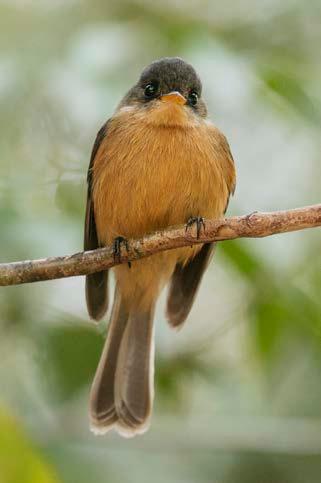

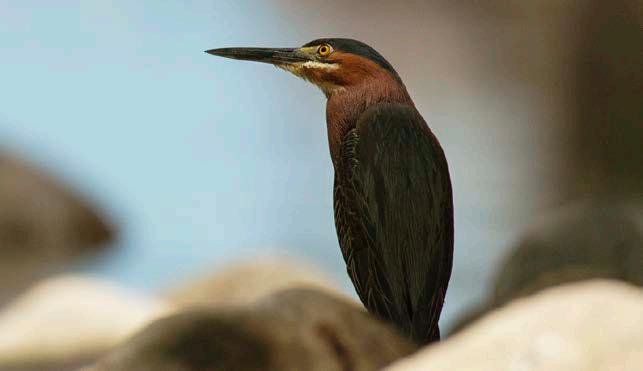
SAINT LUCIA PEWEE
GREEN HERON
PURPLE-THROATED CARIB
LESSER ANTILLEAN BULLFINCHES

Saint Lucia Oriole
The adult oriole grows to about 22 cm in length. It is found in woodlands including dry and moist forest. It is uncommon and perhaps becoming scarcer. It feeds on insects, fruits, flowers and nectar. The oriole builds a nest sewn under a leaf or palm well above the ground.
Saint Lucia Warbler
The Warbler is about 12.5 cm in length. It is found in all forest types and at all altitudes. It forages for insects and spiders from leaves and twigs. It lays in a nicely woven, cup-shaped nest built in a tree about 1-5m above the ground.
Semper’s Warbler
The Semper’s Warbler is extremely rare or possibly extinct. The bird is about 14.5 cm in length. The plumage of the adults is dark grey at the upperparts and greyish white at the underparts. The last reliable sighting was in 1961. There have been unconfirmed sightings in 1965, 1972, 1989, 1995 and 2003. The Saint Lucian species of the House Wren is considered by some as an endemic species (although this is not as yet widely accepted). Another Lesser Antillean endemic bird in Saint Lucia is the endangered White-Breasted Thrasher.



ANTILLEAN CRESTED HUMMINGBIRD
SAINT LUCIA PARROT LESSER



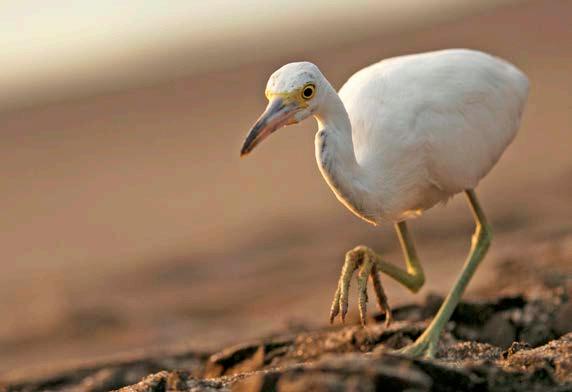
MANGROVE CUCKOO
BROWN BOOBY
LITTLE

Birdwatching at Anse Chastanet
By Martyn Kenefick
Martyn Kenefick is an English “expat” who has lived in Trinidad for the last 14 years since taking early retirement from the Financial Services industry in the UK. Having been an active “birder” since the early 70’s .. He is a freelance ornithologist and bird watching guide. He is the primary author of the recently published Field Guide to the Birds of Trinidad & Tobago and also the Hon Sec of the Trinidad & Tobago Rare Birds Committee”
Four of Saint Lucia’s endemic species can be found within the grounds of Anse Chastanet with the others located not too far away.
Firstly there is the St Lucia Pewee - a delightful small flycatcher; green on top and orange underneath which sallies out from its favored perch in search of prey before returning to the same branch. These can be found both along the entrance track to the resort and also in the estate at Anse Mamin. Next, the St Lucia Warbler, both brightly colored and inquisitive; blue-gray above with bright yellow under-parts and black facial markings, it is widespread throughout the grounds.
Not quite as numerous, but both dramatic and boldly colored is the yellow and black St Lucia Oriole. Back in 1987, there were considered to be less than 60 pairs in existence, however there has been a considerable recovery since and probably two different pairs can be found at Anse Mamin.
Finally, there is “Jacquot,” our national bird, officially known as the St Lucia Parrot or Amazona Versicolor. Threatened by extinction in the 80’s, there now is a flourishing population of perhaps 1,000 birds normally found in the nearby rainforest and high-elevation wooded areas.
Whilst not strictly endemic, two other species easily found on property only occur on one or two nearby islands: the Lesser Antillean Saltator and the Gray Trembler. Both are easily found in the damp lowland deciduous estates and the drier forested slopes.

However, you don’t have to hike into the woods to find a wealth of colorful birdlife. Both Green and Purple-throated Caribs together with their tiny relative the Antillean Crested Hummingbird can be found taking nectar from the flowerbeds surrounding the accommodation areas; both Zenaida Doves and Common Ground-Doves amble along the walkways in the early mornings whilst Scaly-naped Pigeons, Scaly-breasted Thrashers, Tropical Mockingbirds and Gray Kingbirds are ever present along the tree-lined roadways. Overhead, both Broadwinged Hawks and American Kestrels keep an eye out for prey; Magnificent Frigate birds, or “Cisseau” as they are known locally simply hang in the air looking for a free meal whilst in the restaurant, if you don’t keep a watchful eye on your butter or jam, those piratical Lesser Antillean Bullfinches and Bananaquits will enjoy a stolen breakfast.
And a final note on the subject of “special birds.” Keen “birders” will be well aware just how shy and elusive Mangrove Cuckoos are to see - there is nowhere in the world where this species is easier to find than at Anse Chastanet.
SAINT LUCIA ORIOLE
ANSE MAMIN
My birding experiences at Anse Chastanet, Saint Lucia
By Ed Drewitt
Ed Drewitt is a freelance naturalist showing people wildlife around the world. He also studies urban Peregrines and has a book published in June. Ed has been escorting birdwatching groups to Anse Chastanet, Saint Lucia for the past 4 years.
Once you step off the plane onto the runway in St Lucia the hot sunshine hits your skin; the air smells and feels tropical and moist. The lush vegetation and colourful flowers grace towns and villages on your way to Anse Chastanet. On every other power line Grey Kingbirds, a type of flycatcher, stand tall waiting to fly out in a circle to catch an insect while gangs of Carib Grackles, black, glossy birds related to the Starling look for grubs and insects.
Anse Chastanet offers the ideal location to spot common birds of St Lucia including many that are only found on the island (endemics) and is well positioned to travel out from on day trips to see many of the more secretive and rarer birds in the mountain rainforests.
As you enter the Treehouse Restaurant for breakfast it is worth taking your binoculars and camera to spot the local Lesser Antillean Bullfinches, bright yellow Bananaquits, and iridescent Carib Grackles looking for titbits. You may even be lucky to spot a Grey Trembler, quivering its wings in excitement. If you take a table looking out across the tree canopies you have a good chance of spotting some shy species such as the Spectacled Thrush, a brown thrush with yellow colour skin around its eyes.
From the bar you can enjoy the freshest of cocktails while watching Scaly-breasted Thrashers feeding in the adjacent trees, and as the sun drops below the horizon the beautiful song of the Tropical Mockingbird permeates the airwaves. Free-tailed Bats begin to fly around in big numbers, and down by the beach the Yellow-crowned Night Heron may appear to feed on Ghost Crabs.

Keep your eyes up towards the sky – you never know what may pass overhead from Frigate Birds to Brown Boobies, and Peregrines to Ospreys.
Throughout Anse Chastanet, the colourful, tubular flowers provide the perfect food source for hummingbirds. There are three to look for – the Antillean Crested Hummingbird, green with a distinctive crest on its head; the Purple-throated Carib, often looks black but in the right light to a lovely purple or Merlot red; and the Green-throated Carib, a green hummingbird but without the crest.
In the nearby Anse Mamim Broad-winged Hawks and American Kestrels may soar overhead and the woodland is home to Spectacled Thrushes, Black-whiskered Vireos, St Lucia Warblers, and St Lucia Pewees. The stream running through the woods is a good spot to look for Spotted Sandpipers, Little Blue and Green Herons.
The dawn chorus around 6am is a time to listen for the Grey Kingbirds – the main sound you will hear in the morning accompanied by the calls of Zenaida Doves and perhaps the mockingbird.
An early start is also a good time to visit some of the forest nature reserves where you have the chance to see the endemic parrot, the St Lucia Parrot. A colourful bird, this large parrot disappears in its forest habitat as its colours make it very well camouflaged.
St Lucia Pewees, St Lucia Warblers and hummingbirds are all common. And in these areas you may also see or hear the St Lucia Oriole, a black and orange bird with steely grey legs
and beak and the Rufous-throated Solitaire with its beautiful single note song. Meanwhile, the Millet reserve is a good place to watch for the St Lucia Black Finch as it comes to feed on coconuts put out for it.
Whether you just want to chill on the beach or fancy more of an adventure around Anse Chastanet’s estate or further afield into the native forests you can be sure to see something and catch a glimpse of St Lucia’s wild side.
Off-Property Birdwatching Excursions and Activities


While Saint Lucia is a modest sized island 27 miles long and 14 miles across at its widest point, a surprising variety of often dramatically different habitats are found throughout. The island’s east coast is generally rather dry but as the trade winds blow in off the Atlantic they are quickly forced to ascend the interior mountains; the rapidly cooled air is forced to release its moisture creating the island’s lush interior rain forests. Created are a great number of unique habitats where various bird species have become adapted resulting in the large variety of birds found on island.
To ensure an enjoyable birding holiday experience for our guests, Anse Chastanet offers a variety of tours to these very scenic natural environments where an alluring variety of birds are found.
One of the most popular is the Millet Bird Sanctuary Trail which is located in the island’s midsection north of Soufriere. The walk is led by a Department of Forestry guide; over 30 species can be seen along the way, including the five endemic species: the Saint Lucia Black Finch, Saint Lucia Pewee, Saint Lucia Warbler, Saint Lucia Oriole and Saint Lucia Parrot. It takes approximately two hours to complete the relatively easy trail which is perched at about 1,000 feet above sea level.
For those who wish to combine birding with a visit to Saint Lucia’s most lush rain forest we offer excursions to the Des Cartier Trail, which is located inland from the east coast village of Micoud. Following ridge tops at about 1,800-feet above sea level, this relatively easy 1.5 mile loop hike takes you through one of the wettest tropical forests on earth receiving as much as 200 inches of rain annually. The St. Lucia Parrot is readily encountered along this trail which is considered to be one

of the very best birding sites on island.
The dry coastal scrub between the east coast town of Dennery and Praslin village is home to the largest population of the endangered White Breasted Thrashers left in the world. These beautiful birds are regularly encountered when the area is visited with one of Saint Lucia’s experienced birdwatching guides. For those who wish to add a bit of a challenge to their birdwatching, you can climb to the top of Gros Piton, the higher of Saint Lucia’s two iconic mountains.
The Gros Piton Hike offers encounters with a number of rare birds and wildlife that find sanctuary in this rugged and somewhat remote part of the island. The Saint Lucia endemic House Wren, Saint Lucia Oriole, Saint Lucia Black Finch and the Scaly-naped Pigeon are just some of the species that are seen along the trail. Climbing Gros Piton is a strenuous challenge and should be undertaken only by very fit and experienced hikers.
The Forestiere Trail is located just to the east of Saint Lucia’s capital city, Castries. The trail is part of the old French Road which cut across the island’s interior. The island’s endemic species, including the parrot, can be seen along the trail.
A must for our more adventurous visiting bird enthusiasts is a visit to the Edmund Rainforest Reserve which is located in the middle of island and accessed from the Soufriere area. Within the forest the most popular birding trek is the Enbas Saut Falls Trail which passes through one of the most remote, wild and unbelievably scenic parts of the island. The trail features a combination of Rainforest, Cloud Forest and Elfin Woodlands as well as encounters with the Saint Lucia Parrot, Saint
MARIA ISLANDS
YELLOW CROWNED NIGHT HERON
SPOTTED SANDPIPER
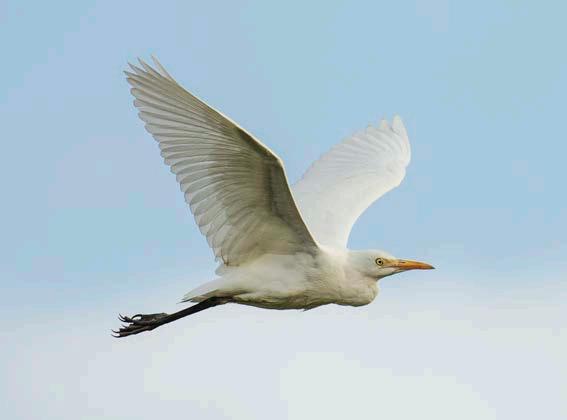

Lucia Oriole, Saint Lucia Black Finch, Antillean Euphonia and Rufous-throated Solitaire. The trail is also famous for its two cascading waterfalls and pools at the head of the Troumassee river. Enbas Saut is a challenging and strenuous hike and should be attempted only by those with an above average fitness level.
The Tet Paul Nature Trail is ideal for birders who wish to enjoy from up high the majestic beauty of the world’s most famous pair of mountains without doing any serious hiking or climbing. The trail, which is approximately ½ mile in length, affords an easy stroll through the cool air in the midst of St. Lucia’s World Heritage site. Great views of both Gros Piton and Petit Piton, the island’s southern region and the blue Caribbean below abound and numerous species of birds are viewed all along the way.
A very popular activity for visiting bird watchers to enjoy in Saint Lucia is Dolphin and Whale Watching which combines wonderful sightseeing, viewing sea birds and the opportunity for up close encounters with several species of sea mammals. Saint Lucia is fortunate to have several experienced operations which feature large, comfortable boats who communicate and work together to dramatically increase the odds of encountering whales.
Cape Moule a Chique is a rugged and lofty crag on the very southern tip of Saint Lucia near the town of Vieux Fort. Perched on the top is a lighthouse which, located at an elevation of over 800 feet, is the third highest in the world. A road winds to the top of the cape providing encounters with birds along the way. A variety of tropical birds nest below the lighthouse and the surrounding area


including red-billed Tropicbirds, a ‘must see’ species for birdwatchers. From Moule a Chique guests also are treated to a panoramic view of the southern half of the island and the Maria Islands lying directly below.
The Maria Islands are a protected nature reserve located a half mile off Pointe Sable on the southeast coast. The islands are a major nesting site for migratory birds which travel thousands of miles from the west coast of Africa to nest annually. They are also home to five endemic reptile species including the world’s rarest snake, the Kouwés snake (Saint Lucia Racer), the Saint Lucia Whiptail lizard (Zandou), and the Worm Snake, listed in the Guinness Book as the world’s smallest. The Maria Islands can only be visited through special arrangements with the Saint Lucia National Trust.
Adjacent to the Hewannorra International Airport are the Vieux Fort Wetlands which comprise approximately 6 acres attracting several bird species throughout the year. Many varieties of ducks, herons, sand pipers, plovers, egrets, gallinules, rails and other shorebirds can be seen.
Grande Anse, a mile long pristine beach located on the east coast, is best known as a Leatherback Turtle nesting site and as being part of the Saint Lucia’s Iguana Reserve, but the area also offers enjoyable birdwatching. The Saint Lucia endemic Rufous Nightjar is regularly seen along with many other species. Geographically, Grande Anse is located not far from the city of Castries and other well populated areas in the north of the island, but the challenging 4-wheel track leading in makes it seem to be one of the most remote tropical paradise locations in Saint Lucia.
CATTLE EGRET
GREY TREMBLER
GREY KINGBIRD
SAINT LUCIA EAST COAST
Saint Lucia Map
George

Anse

SCUBA





To Anse Mamin Beach and Bike St. Lucia
Jade Mountain



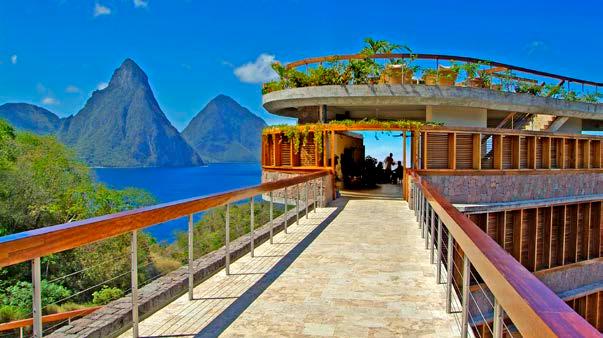
Rising majestically above the 600 acre beach front resort of Anse Chastanet, Jade Mountain is a cornucopia of organic architecture celebrating St Lucia’s stunning scenic beauty.
Architect owner Nick Troubetzkoy has expanded upon his philosophy of building in harmony with Caribbean nature in his creation of Jade Mountain. The bold architectural design – individual bridges leading to exceptional infinity pool sanctuaries and rugged stoned-faced columns reaching towards the sky – makes Jade Mountain one of the Caribbean’s most mesmerizing resort experiences.
Expect grand sweeping spaces where bedroom, living area and an extravagant private infinity pool glide into one another to form extraordinary platforms floating out into nature. With the fourth wall entirely absent, Jade Mountain’s sanctuaries are stage-like settings from which to embrace the full glory of St Lucia’s Pitons World Heritage Site, and of course, the eternal Caribbean Sea.
Wrapped around an infinity pool with a dazzling kaleidoscope of colors, the Jade Mountain
Club caters exclusively to resident guests, celebrating James Beard Award winner Chef Allen Susser’s “Jade Cuisine.” Hovering in space above the Jade Mountain Club is the Celestial Terrace, perfect for sunset cocktails or star-gazing.
A wide range of spa services can be enjoyed in the privacy of the Jade Mountain sanctuaries or at Kai en Ciel, Jade Mountain’s boutique spa and fitness studio.
The Jade Mountain sanctuaries are deliberately techno-free; there are no telephones, radios or televisions. Internet access is available at reception for those who simply cannot let go of the outside world as the resort encourages you to! The resort major domos and a dedicated resort team ensure outstanding service around the clock.
Enjoy the exclusivity and privacy of Jade Mountain plus all of Anse Chastanet’s restaurants, bars, boutiques, art gallery, spa, scuba, bike and watersports facilities as well as 2 soft sand beaches available to Jade Mountain guests at all times.
Pied-billed Grebe
Great Shearwater
Sooty Shearwater
Audubon’s Shearwater
Black-capped Petrel
White-tailed Tropicbird
Red-billed Tropicbird
Masked Booby
Brown Booby
Red-footed Booby
Brown Pelican
Anhinga
Magnificent Frigatebird
Great Blue Heron
Great Egret
Little Egret
Snowy Egret
Western Reef-Heron
Little Blue Heron
Tricolored Heron
Cattle Egret
Green Heron
Black-crowned Night-Heron
Yellow-crowned Night-Heron
Glossy Ibis
Eurasian Spoonbill
Roseate Spoonbill
American Flamingo
Fulvous Whistling-Duck
Black-bellied Whistling-Duck
Green-winged Teal
Northern Pintail
Blue-winged Teal
Northern Shoveler
Gadwall
American Wigeon
Ring-necked Duck
Lesser Scaup
Ruddy Duck
Masked Duck
Osprey
Northern Harrier
Common Black-Hawk
Broad-winged Hawk
Red-tailed Hawk
American Kestrel
Merlin
Peregrine
Sora
Purple Gallinule
Common Gallinule
American Coot
Caribbean Coot
Black-bellied Plover
American Golden Plover
Collared Plover
Semi-palmated Plover
Killdeer

American Oystercatcher
Black-necked Stilt
Greater Yellowlegs
Lesser Yellowlegs
Solitary Sandpiper
Willet
Spotted Sandpiper
Whimbrel
Hudsonian Godwit
Ruddy Turnstone
Red Knot
Sanderling
Semi-palmated Sandpiper
Western Sandpiper
Least Sandpiper
White-rumped Sandpiper
Baird’s Sandpiper
Pectoral Sandpiper
Dunlin
Stilt Sandpiper
Buff-breasted Sandpiper
Ruff
Short-billed Dowitcher
Wilson’s Snipe
Pomarine Jaeger
Parasitic Jaeger
Laughing Gull
Black-headed Gull
Ring-billed Gull
American Herring Gull
Gull-billed Tern
Black-legged Kittiwake
Caspian Tern
Royal Tern
Sandwich Tern
Roseate Tern
Common Tern
Least Tern
Bridled Tern
Sooty Tern
Brown Noddy
Rock Pigeon
Scaly-naped Pigeon
White-crowned Pigeon
Eurasian Collared Dove
Zenaida Dove
Eared Dove
Common Ground-Dove
Bridled Quail-Dove
Ruddy Quail-Dove
St Lucia Parrot
Yellow-billed Cuckoo
Black-billed Cuckoo
Mangrove Cuckoo
Smooth-billed Ani
Common Nighthawk
Rufous Nightjar
Black Swift
Short-tailed Swift
Lesser Antillean Swift
Alpine Swift
Purple-throated Carib
Green-throated Carib
Antillean Crested
Hummingbird
Belted Kingfisher
Caribbean Elaenia
St Lucia Pewee
Lesser Antillean Flycatcher
Gray Kingbird
Fork-tailed Flycatcher
Caribbean Martin
Bank Swallow
Cliff Swallow
Cave Swallow
Barn Swallow
House Wren
Rufous-throated Solitaire
Spectacled Thrush
Forest Thrush
Tropical Mockingbird
White-breasted Thrasher
Scaly-breasted Thrasher
Pearly-eyed Thrasher
Gray Trembler
Yellow-throated Vireo
Red-eyed Vireo
Black-whiskered Vireo
Northern Parula
Yellow Warbler
Cape May Warbler
Yellow-rumped Warbler
St Lucia Warbler
Palm Warbler
Blackpoll Warbler
Black and White Warbler
American Redstart
Prothonotary Warbler
Ovenbird
Northern Waterthrush
Louisiana Waterthrush
Semper’s Warbler
Canada Warbler
Bananaquit
Antillean Euphonia
Scarlet Tanager
Lesser Antillean Saltator
Rose-breasted Grosbeak
Black-faced Grassquit
Lesser Antillean Bullfinch
St Lucia Black Finch
Grassland Yellow-Finch
Bobolink
Carib Grackle
Shiny Cowbird
St Lucia Oriole
Baltimore Oriole
GREEN THROATED CARIB
